Extras
Extras are additional options or add-ons that can be included with products. They can encompass various enhancements or services, such as special finishes, additional retouching, print mounting, glass, or any other additional features that may incur an extra charge.
Extras can be added to a wide range of products, including Prints and Gallery Wraps. These options allow Clients to customize their orders and choose specific enhancements or additions to meet their preferences and requirements.
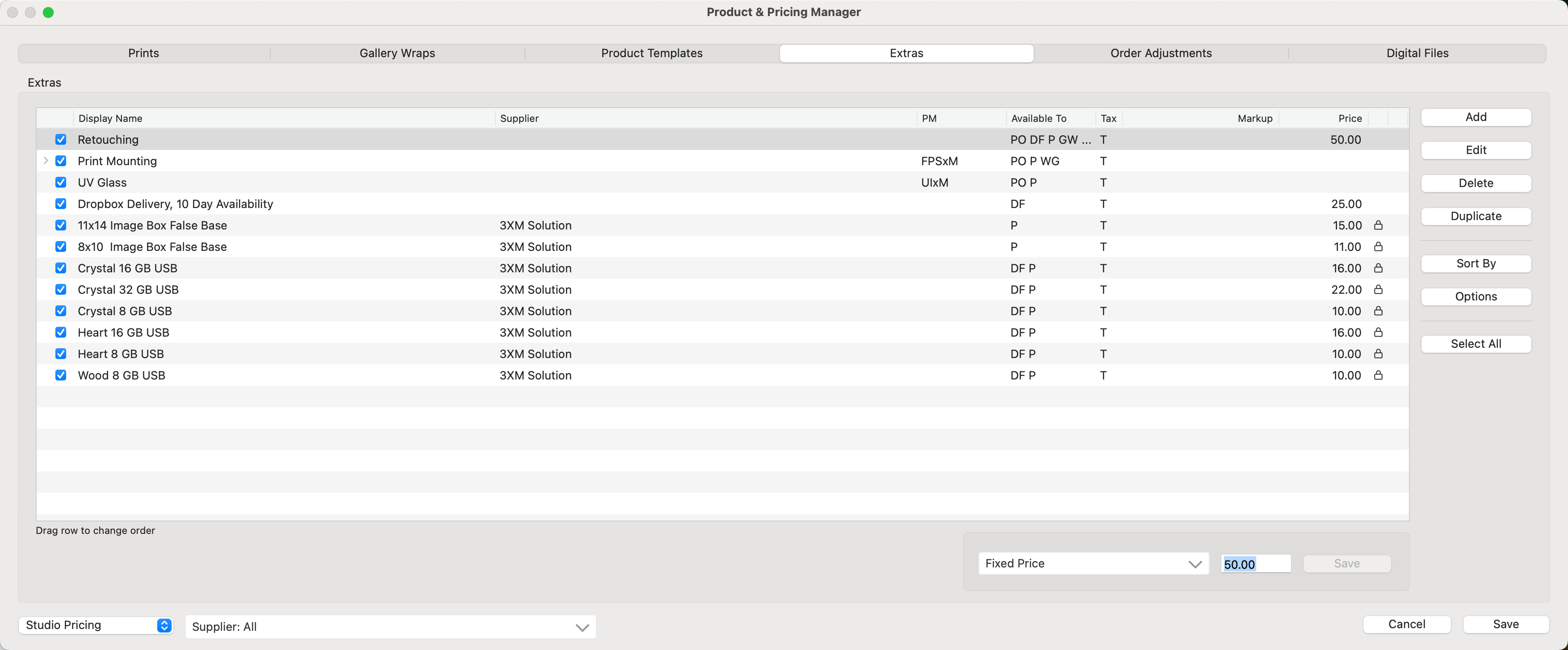
- Choose a Supplier from the drop-down list on the Bottom Bar to exclusively display products associated with a particular supplier.
- Toggle your pricing method between "Supplier Cost x Markup" and "Fixed Price."
Before you start pricing your products, be sure you have selected the applicable price list from the drop-down menu on the bottom left.
To toggle between pricing methods, use the drop-down arrow in the Pricing Method box (below the Pricing panel).
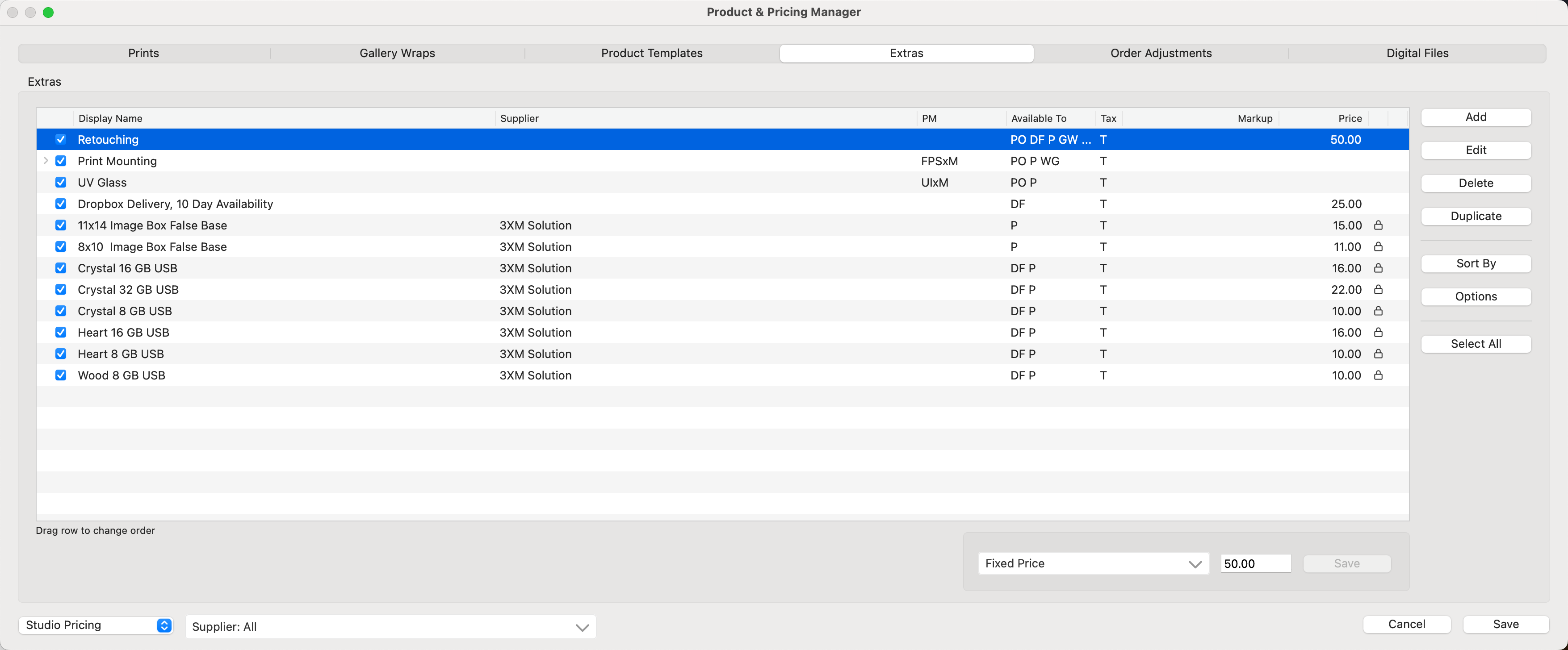
 Drop-Down Arrow: This allows you to expand or collapse items. The drop-down arrows only appear when FPS sizing is being used.
Drop-Down Arrow: This allows you to expand or collapse items. The drop-down arrows only appear when FPS sizing is being used. : This checkbox indicates that the product is "turned on" and available in the current price list. Uncheck this box if you do not want a particular product to appear.
: This checkbox indicates that the product is "turned on" and available in the current price list. Uncheck this box if you do not want a particular product to appear. - Display Name: This is a description of the product.
- Supplier: This column indicates the Supplier if one has been assigned.
- PM: Automatic Pricing Method. Extras can be priced in several ways. An abbreviation of the method is shown here. If you are using a markup, (xM) will appear. If you are charging an additional fixed cost, (+F) will appear here.
- Available To: Extras can be made available to different product types when applicable. An acronym of the product type which uses the particular Extra is listed here.
- Product Code: If you have enabled product codes in your Settings, this is where they appear.
- Tax: a T indicates the item is taxable. An N indicates the item is non-taxable.
- Markup: If you choose to use a markup, the markup amount will be displayed here.
- Price: This column indicates the selling price of your product.
 Lock: This particular product is from a Supplier Collection and cannot be modified (except for the price).
Lock: This particular product is from a Supplier Collection and cannot be modified (except for the price).- You can change the order of the products by selecting a row and dragging it to where you want it to be.
PO - Print Orders
P - Products
DF - Digital Files
GW - Gallery Wraps
WG - Wall Groupings
Automatic pricing methods can be used to calculate the price of an item based on its size. These methods work for Extras, Frames, and Mats. Using automatic pricing methods can greatly simplify your price list because you only need one price list entry for any ordered size. Because you can also specify different “rates” for the same item in each of your price lists, your prices can easily change when you change to a different price list.
The following Pricing Methods are available:
- Fixed price - Items using this method are priced at the specified price regardless of size.
- UI: United Inches - The price is calculated by adding the width and height of the outside of the print or product (the mat size) and multiplying it by the rate in the price list.
- UC: United Centimetres - Same as United Inches, but in metric units.
- AF: Area sq. ft - The price is calculated by multiplying the width and height of the outside of the print or product (the mat size) and multiplying it by the rate in the price list.
- AI: Area sq. in - Same as Area sq. ft. but in inches.
- AM: Area sq. m - Same as Area sq. ft. but in metric units.
- UIF: United Inches Framed - The price is calculated by adding the width and height of the outside edge including the frame and multiplying it by the rate in the price list. For items without a frame, this will be the same value as United Inches. This calculation includes a standard 1/4” (6mm) rabbet (overhang) on the frame.
- UCF: United Centimetres Framed - same as United Inches Framed, but in metric units.
- FPS: Fixed Price by Size - This price allows you to set a price for specific sizes of items. See the Fixed Price by Size section for more information.
In addition to these automatic pricing methods, you may want to include an additional fixed cost (+F) or markup (xM).
If the price of an extra is not showing as a line item, this is because it requires a product to calculate the actual price. Once a product is ordered, and the extra is applied, the final price will appear on the invoice. A good example of this is pricing using United Inches (UI). The final price is dependent on the print size ordered.
- Click the Add button on the right-hand side of the Extras Pricing panel. The Extras dialog will appear.
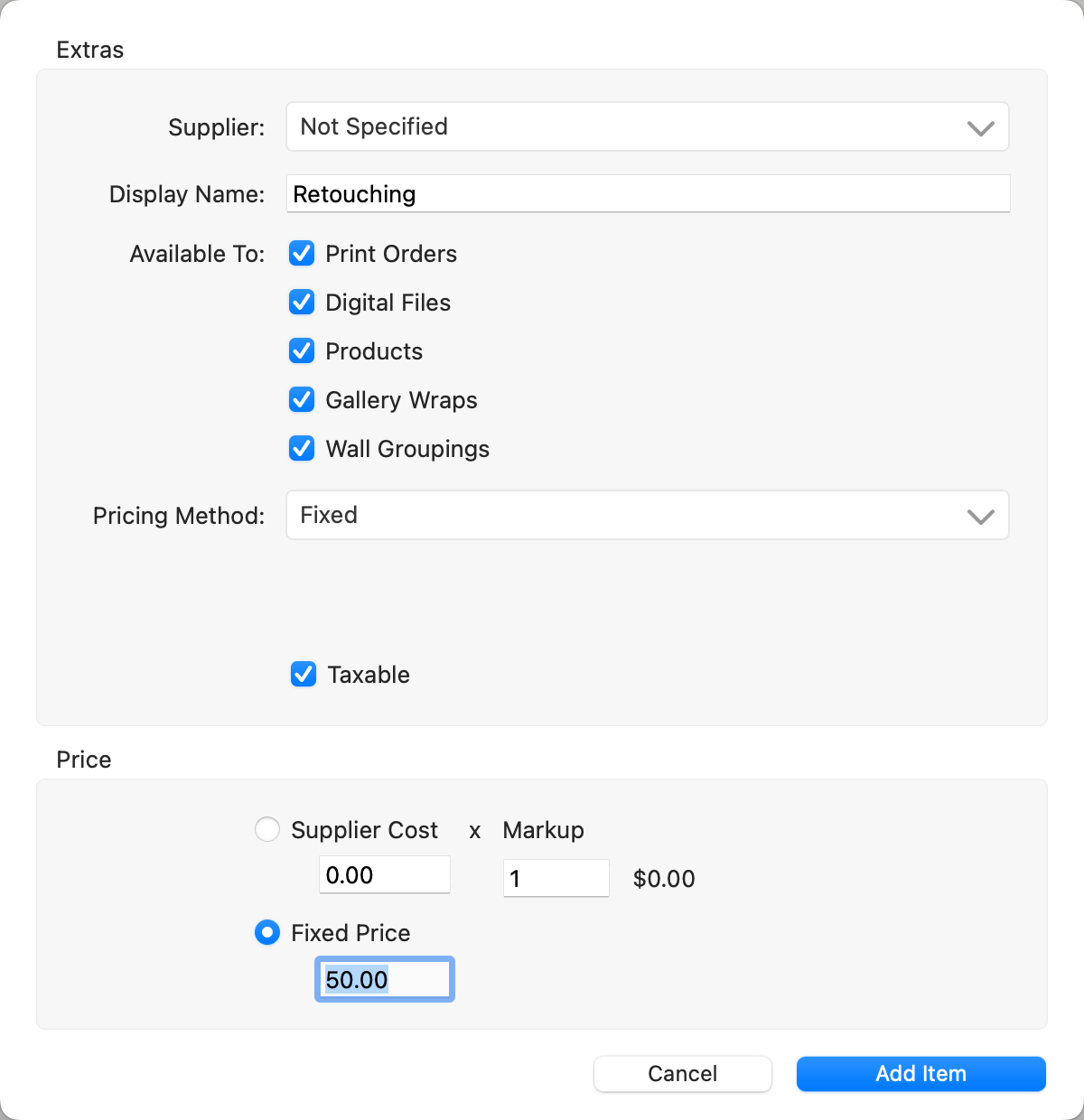
- Supplier: Choose a supplier from the drop-down list if you want to assign a supplier to the Extra.
- Display Name: Type in a description of the new extra you would like to add.
- Available To: Check the boxes of each product type you want to enable with the option of this extra.
- Pricing Method: Select "Fixed."
- Product Code: If enabled, one will be auto-generated.
- Check the Taxable box if you wish the product to be taxed.
Price
Choose Either Supplier Cost x Markup or Fixed Cost:
- Supplier Cost x Markup: This pricing method is best used when Importing Pricing From a Spreadsheet.
- Enter the Supplier Cost and markup in this dialog.
- If you choose this method of pricing, price rounding (if enabled) will be shown.
- Profit Margins are also shown when using this pricing method.
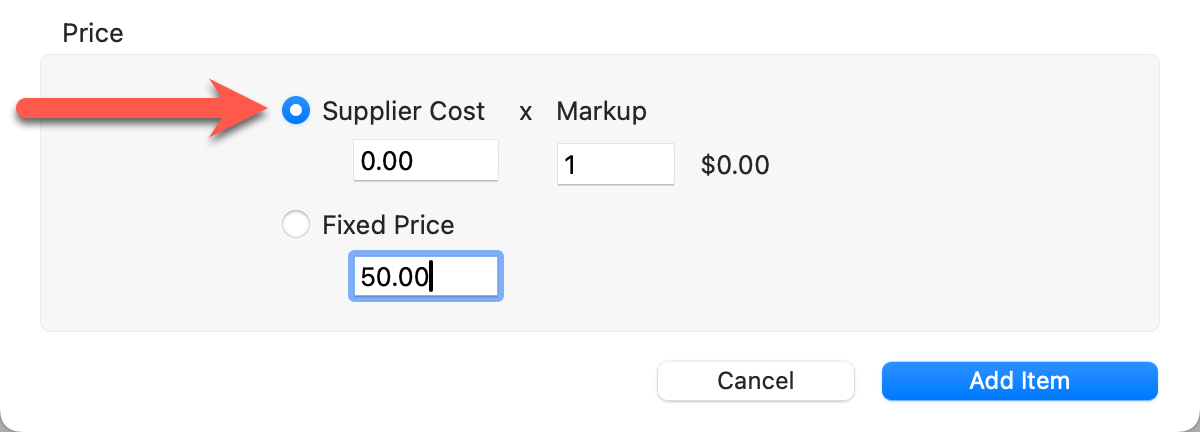
- Fixed Price: Select this option to enter a fixed price. This can also be done after you add the item.
- If you elect to use a fixed price, you can still have the Supplier Cost listed (just not selected).
- Profit margins will be shown if the Supplier Cost is entered.
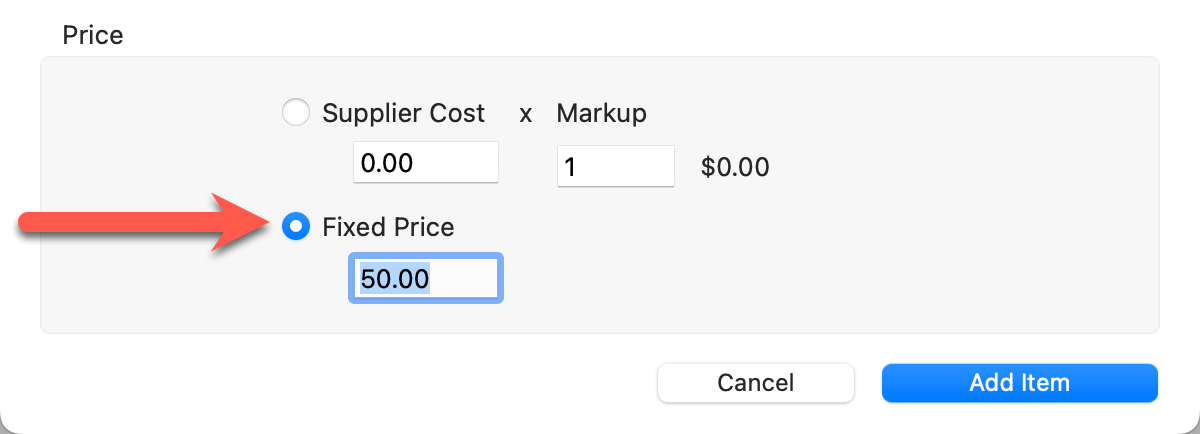
- Click the Add Item button.
- Your new Extra will appear at the bottom of the list by default. You can drag and move it wherever you like in the list.
- Click the Add button on the right-hand side of the Extras Pricing panel. The Extras dialog will appear.
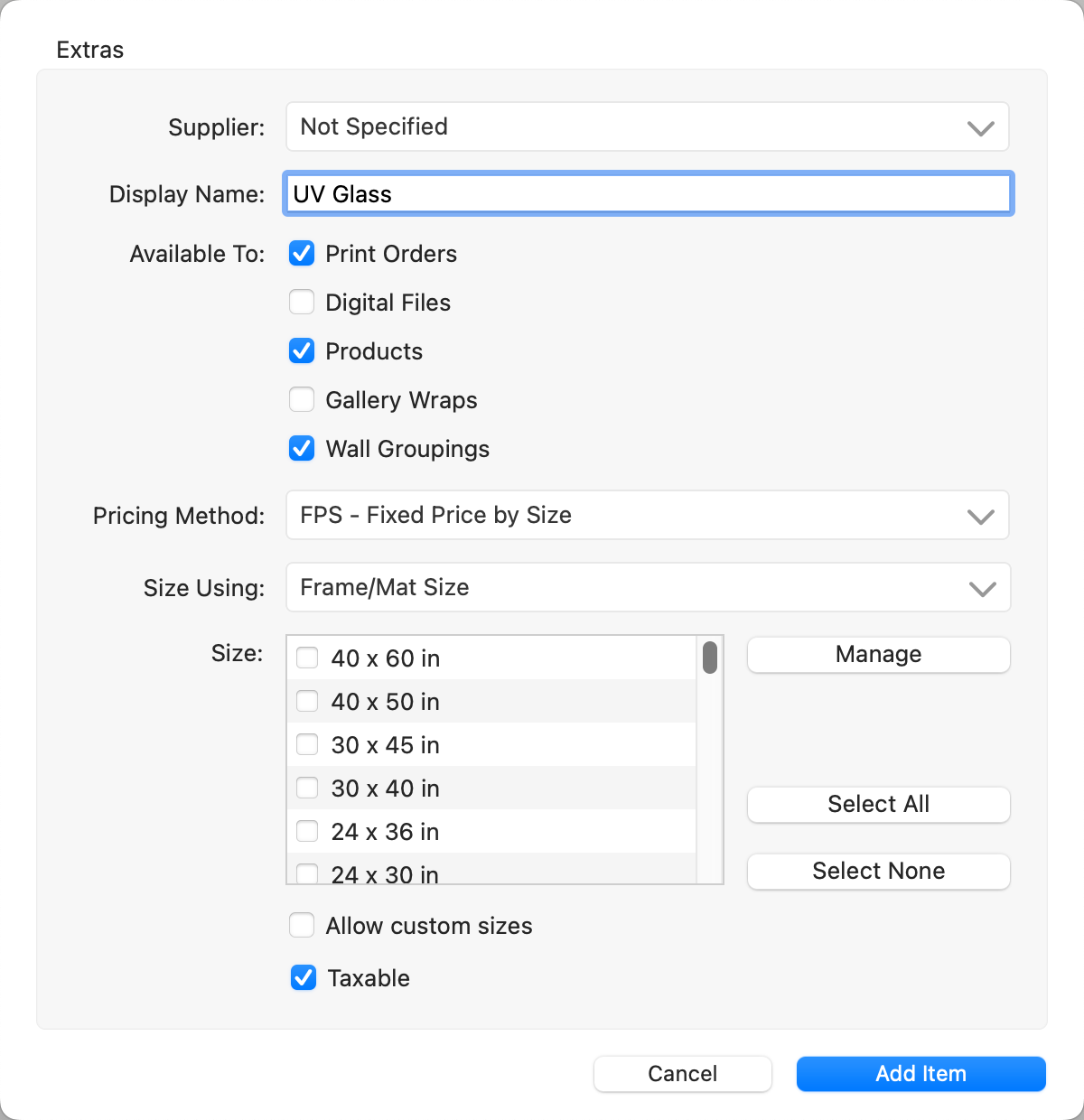
- Supplier: Choose a supplier from the drop-down list if you want to assign a supplier to the Extra.
- Display Name: Type in a description of the new extra you would like to add.
- Available To: Check the boxes of each product type you want to enable with the option of this extra.
- Pricing Method: Select "Fixed Price by Size". Click on Fixed Price by Size to learn more about that particular pricing method.
- Size Using: There are two options to choose from, based on how your print lab charges for frames and mats.
- Frame/Mat Size: Selecting Frame/Mat Size will trigger a price based on the size of the mat that would always equal the size of the frame. Most labs and framers use this size/pricing method. If you are unsure, choose Frame/Mat Size.
- Print Size: Selecting Print Size will trigger a price based on the size of the print regardless of the size of the mat or frame. In the example shown, with the Print Size selection, the frame and/or traditional mat would be priced at the 5x7 cost, although the frame and mat size are 8x10. The Print Size setting is rarely used.
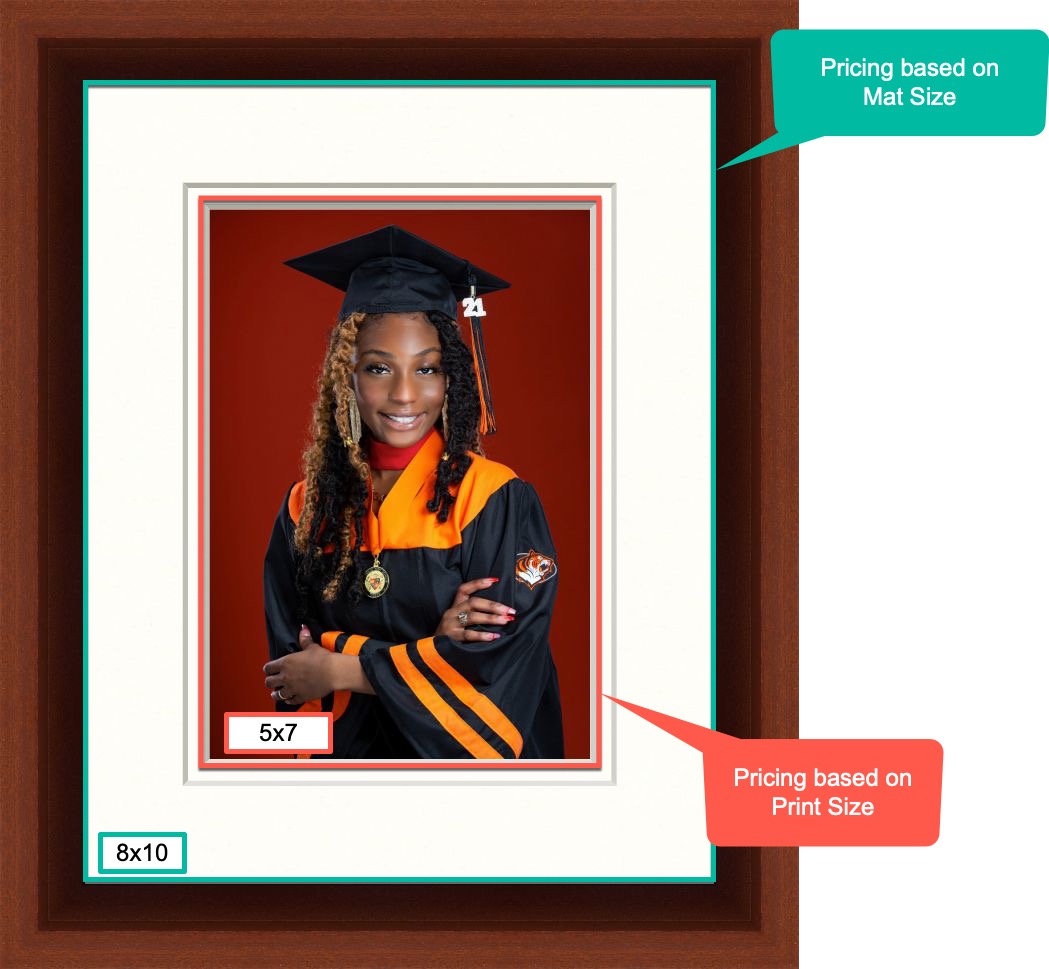
- Size: Use the checkboxes to add as many new sizes as you would like.
- The size list is based on what has been set up in Paper Sizes.
- If the paper size you want is not listed, click on the Manage button. (this will take you to the Setup Paper Sizes dialog).
- Use the Select All button to select all sizes.
- If you want to offer "Custom Sizes," check the Allow Custom Sizes checkbox.
- Product Code: If enabled, codes will be auto-generated.
- Check the Taxable box if you wish the product to be taxed.
- Click the Add Item(s) button.
Pricing
Pricing FPS Extras is done after they are added.
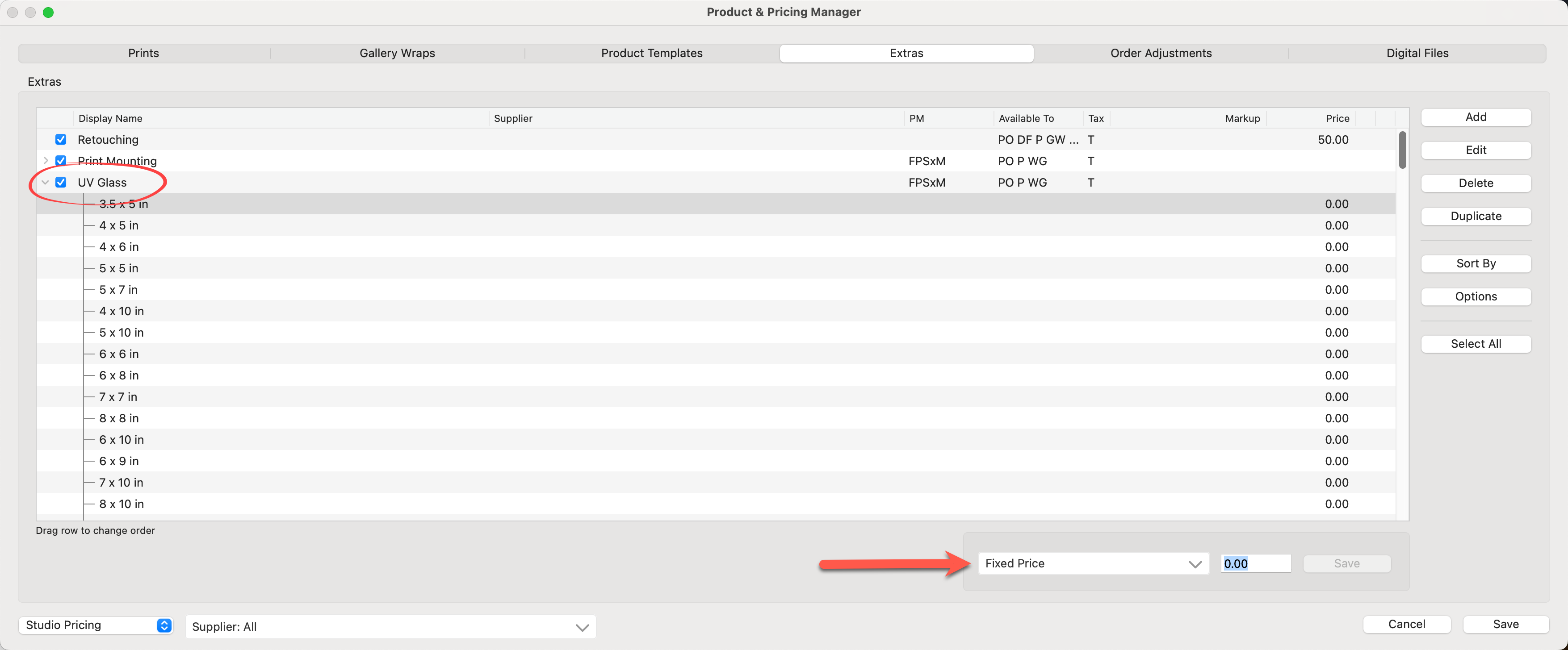
- Use the drop-down arrow to reveal all the sizes included in the Extra.
- Individually price each size available using either "Fixed Price" or "Supplier Cost x Markup."
- The Supplier Cost x Markup method is best used when Importing Pricing From a Spreadsheet.
This method for pricing your products works in the same way for Prints, Gallery Wraps, Extras, Order Adjustments, and Digital Files. To toggle between pricing methods, use the drop-down arrow in the Pricing Method box (below the Print Pricing panel).
Price Using "Fixed Price"
- Click on the row you wish to price.
- Type in a price in the Fixed Price box.
- Press ReturnEnter on your keyboard or click the Save button. You will automatically move to the next row.
- Once you are finished pricing all your products, click the Save button in the bottom-right of the Product & Pricing Manager. This will save all changes and close the window.
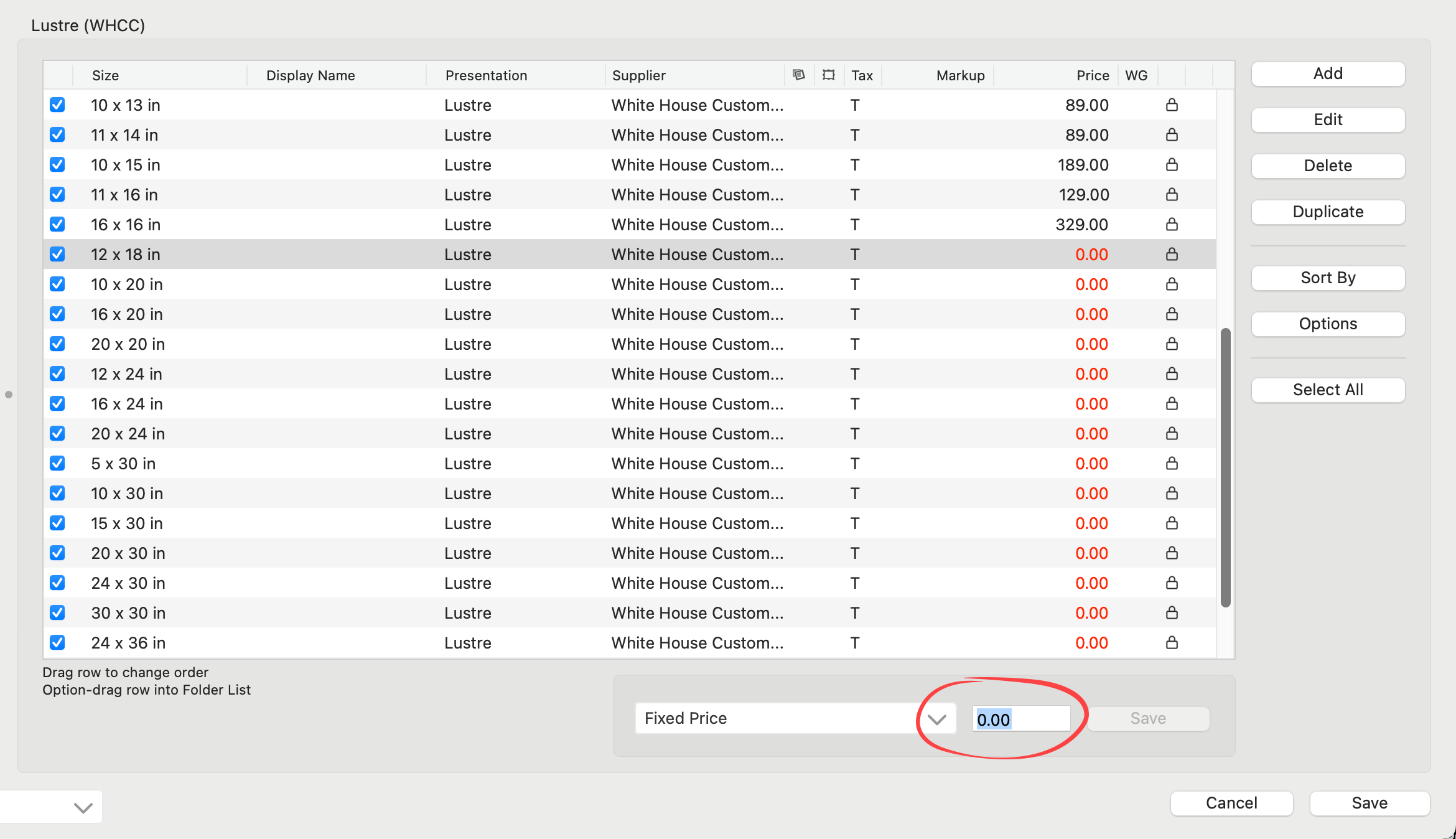
Price Using "Supplier Cost x Markup"
- This pricing method is best used when Importing Pricing From a Spreadsheet. You can also modify the markup of a locked Supplier Collection.
- Select each size individually and click Edit button to modify the supplier cost.
- Use the Select All button to select all print products to modify the markup on all the products at the same time.
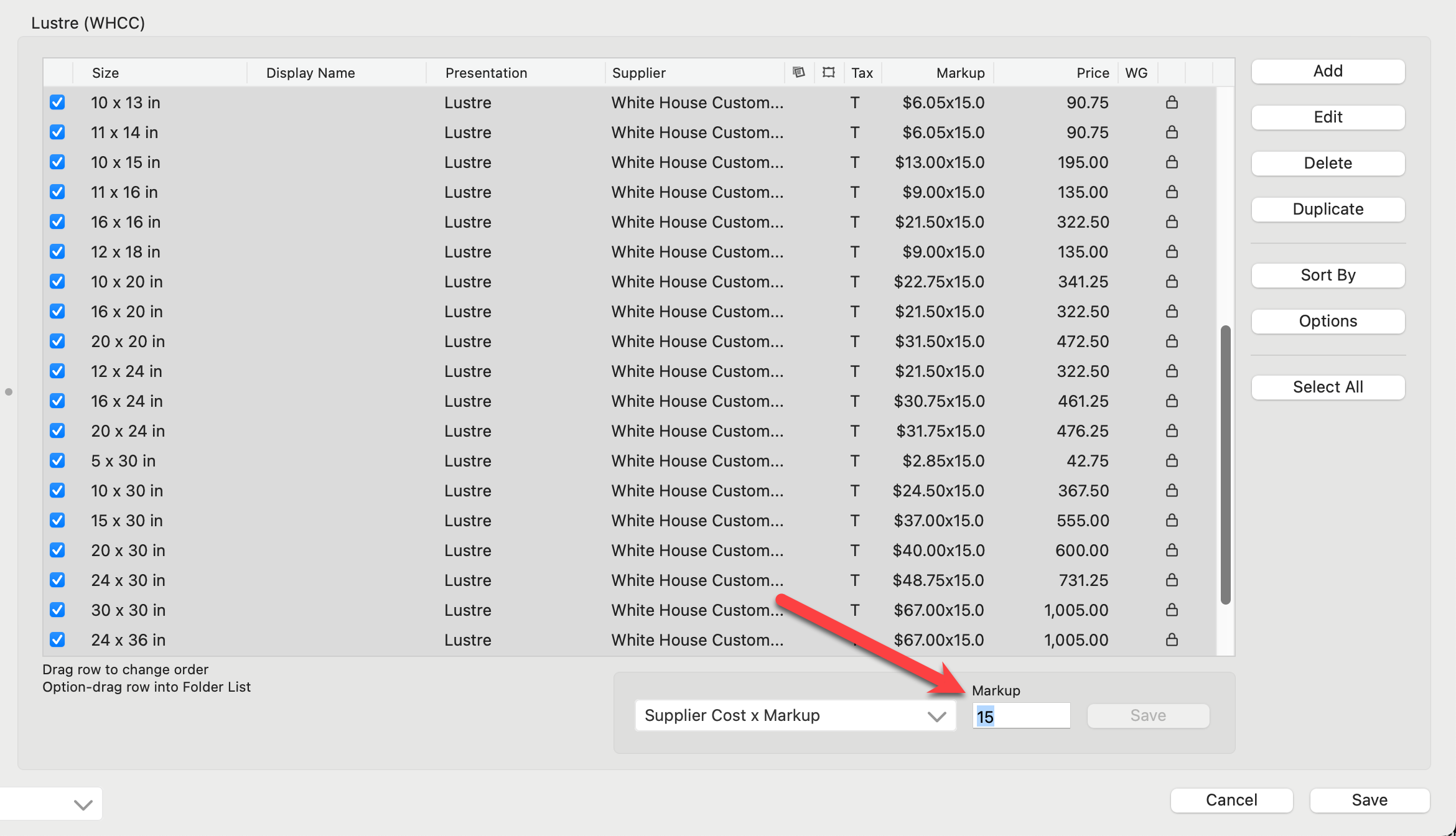
When entering a price, hold down the OptionAlt key while clicking the Save button. This will save that price across ALL price lists.
- You can manage and update your prices using CSV file spreadsheets. Click here to learn more.
- Use the Select All button to make changes to all of the products at the same time. This works well when you are adding a universal markup.
- Click the Add button on the right-hand side of the Extras Pricing panel. The Extras dialog will appear.
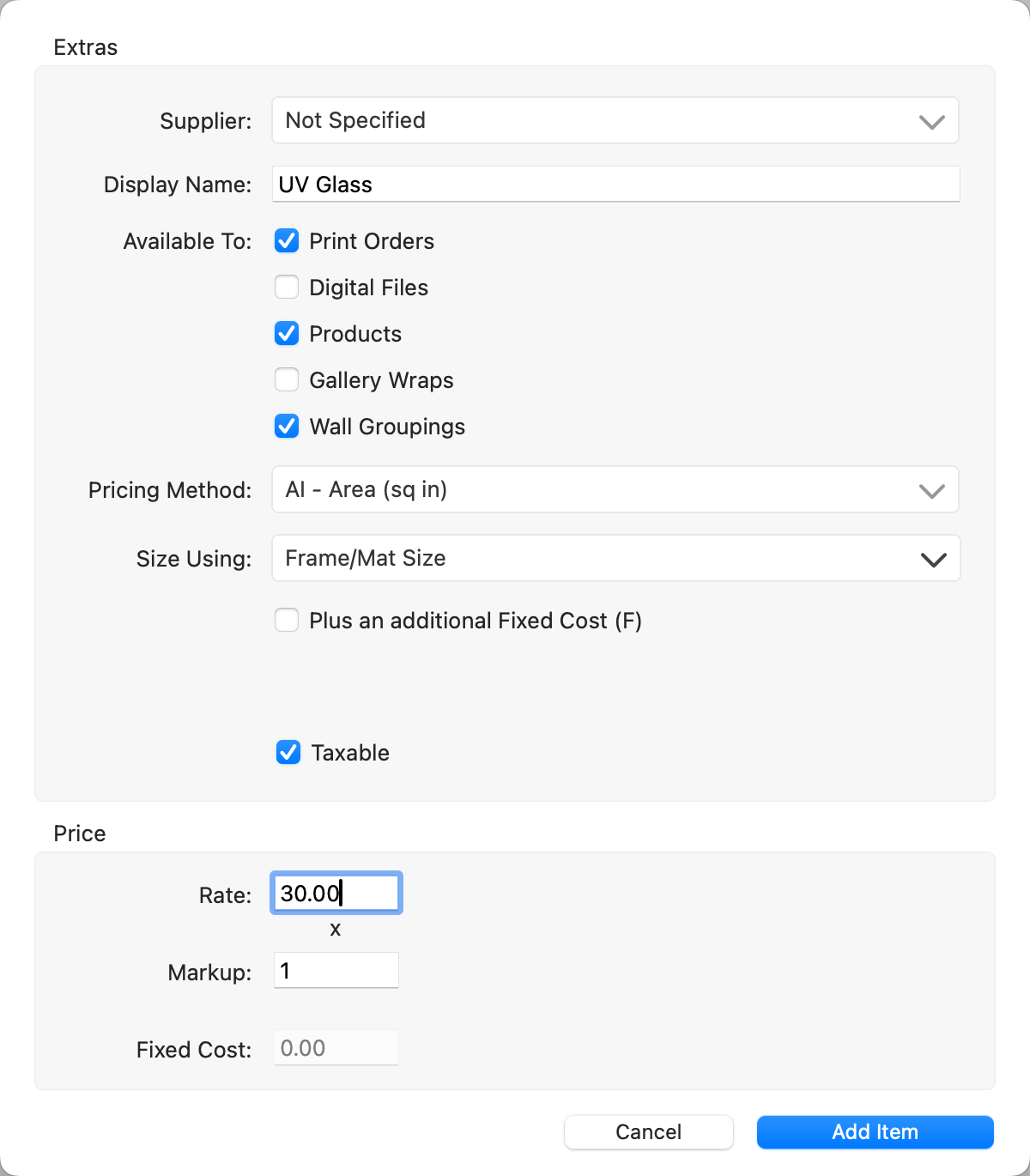
- Supplier: Choose a supplier from the drop-down list if you want to assign a supplier to the Extra.
- Display Name: Type in a description of the new extra you would like to add.
- Available To: Check the boxes of each product type you want to enable with the option of this extra.
- Pricing Method: Select a pricing method.
- Size Using: There are two options to choose from, based on how your print lab charges for frames and mats.
- Frame/Mat Size: Selecting Frame/Mat Size will trigger a price based on the size of the mat that would always equal the size of the frame. Most labs and framers use this size/pricing method. If you are unsure, choose Frame/Mat Size.
- Print Size: Selecting Print Size will trigger a price based on the size of the print regardless of the size of the mat or frame. In the example shown, with the Print Size selection, the frame and/or traditional mat would be priced at the 5x7 cost, although the frame and mat size are 8x10. The Print Size setting is rarely used.

- Check the box if you wish to add an additional fixed cost. This is useful when you have a fixed assembly cost plus a size-dependent part to your automatic pricing method. When this option is selected, the pricing method will display with a +F next to it in the Extras Pricing panel.
- Product Code: If enabled, one will be auto-generated.
- Check the Taxable box if you wish the product to be taxed.
Price
- Rate: This is the price per unit.
- Markup: Optionally add a markup.
- Fixed Cost: If you checked the "Plus an additional fixed cost" box, enter that amount here.
- Click the Add Item button.
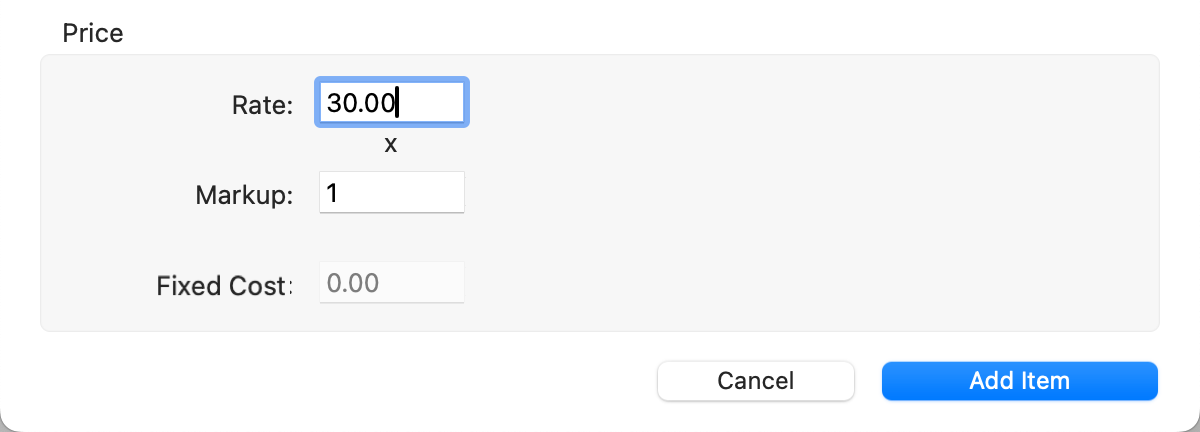
When using this type of pricing method, an actual value for the item cannot be calculated until the extra is "applied" to a product. For instance, ProSelect needs to know the size of the print before it can calculate the price per square foot of the Extra.
- Select the product template you wish to work with.
- Click on the Pricing button.
- Click the Edit button on the right-hand side of the Price List Items dialog.
- The Product Pricing dialog will appear.
- Make changes to the presentation option, size, price, etc.
- You will notice the Reset Changes tool
 appear next to each line item that was edited. To clear your changes for that particular line item, click the Reset Changes tool.
appear next to each line item that was edited. To clear your changes for that particular line item, click the Reset Changes tool. - Click the Change Item button when you are finished.
Products from Supplier Collections cannot be modified (except for price). They are locked.
You can select multiple products at a time and make changes. This method works the same for all products in the Product & Pricing Manager.
Note: If one property is the same for all the selected items, it will be displayed. If the properties are different, then that property will be displayed blank.
- Individually select the rows of products you wish the change. Or use the Select All button.
- Click the Edit button on the right-hand side of the Product Pricing panel.
- Make the change(s) you wish to make.
- You will notice the Reset Changes tool
 appear next to each line item that was edited. To clear your changes for that particular line item, click the Reset Changes tool.
appear next to each line item that was edited. To clear your changes for that particular line item, click the Reset Changes tool. - Click the Save button to apply your changes to all of the selected products.
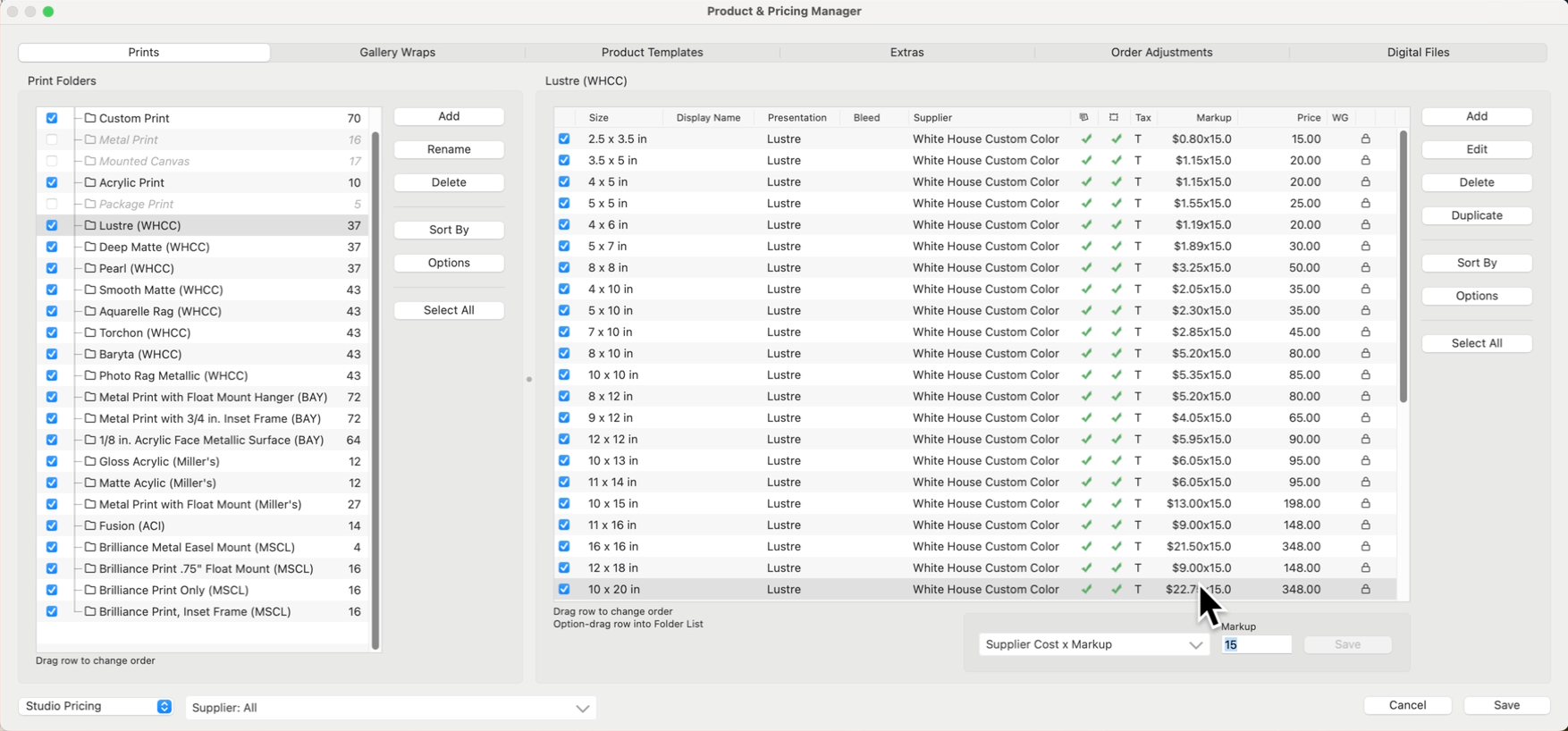
Important note: instead of deleting a product, consider unchecking the checkbox. This will remove it from the price list, but you can always turn it on again at a later time.
- Select the row of the product you wish to delete.
- Click the Delete button on the right-hand side of the Pricing panel.
- A confirmation window will open, click Yes to remove the price list item.
Hold the OptionAlt key down while clicking the Delete button. This will delete the price list item immediately without asking for confirmation first.
It is possible to end up with more than one price list item being exactly the same by changing multiple items at once or by using the Duplicate button. In general, you want to avoid the confusion of duplicates. It is recommended that you delete any remaining duplicates after you have finished with your changes.
![]() Duplicates have a warning symbol next to them on the right-hand side.
Duplicates have a warning symbol next to them on the right-hand side.
There may be instances where you want to create a duplicate. For example, you may want to duplicate a product and edit it rather than create a new product altogether.
Duplicate a Product
- Select the row of the product you wish to duplicate.
- Click the Duplicate button on the right-hand side of the Pricing panel.
- A confirmation window will open, click Yes to duplicate the item.
- The duplicate will appear by default at the bottom of the list.
The Sort By button is contextual. This means that depending on which type of product you are working with, different options will appear in your sort button. Sorting takes place within the individual folders. Some common ways of sorting are:
- Width
- Height
- Presentation Option
- Price
- Available To
- Display Name
If you have manually moved your products around by dragging them, the Sort By button will override this. In case you accidentally sort your products and wish to reverse it, click the Cancel button. Using the Undo button will not undo sorting.
- Supplier: Assign a supplier to the selected item(s).
- Generate Import Spreadsheet/Import: Use these options to import prices from a CSV spreadsheet.
- Export/Update Prices: Use these options to update your pricing using a CSV spreadsheet.
- Copy Price to All Price Lists: Use this button to copy the selected item(s) prices across all price lists. To copy the entire folder, click on the Select All button first, and then "Copy Price to All Price Lists."